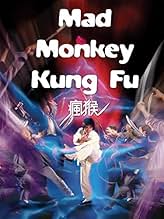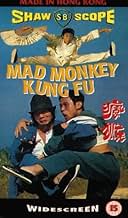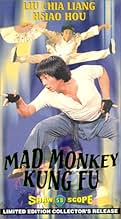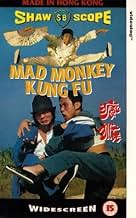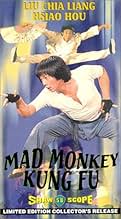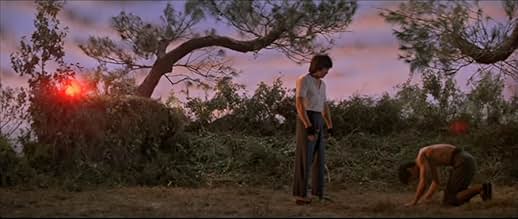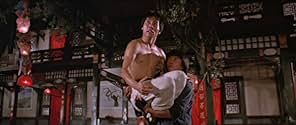VALUTAZIONE IMDb
6,7/10
1252
LA TUA VALUTAZIONE
Aggiungi una trama nella tua linguaA kung fu expert is tricked by a gangster into believing he has committed adultery, so his sister becomes a concubine, and his hands are damaged beyond repair. Years later, he teaches a stre... Leggi tuttoA kung fu expert is tricked by a gangster into believing he has committed adultery, so his sister becomes a concubine, and his hands are damaged beyond repair. Years later, he teaches a street hustler Monkey Kung-Fu, and they take revenge.A kung fu expert is tricked by a gangster into believing he has committed adultery, so his sister becomes a concubine, and his hands are damaged beyond repair. Years later, he teaches a street hustler Monkey Kung-Fu, and they take revenge.
- Regia
- Sceneggiatura
- Star
- Premi
- 1 candidatura in totale
Kara Ying Hung Wai
- Miss Chen
- (as Ying-Hung Hui)
Wing-Hon Cheung
- Green Dragon
- (as Yung-Han Chang)
Fung Ging-Man
- Stage Manager
- (as Ging-Man Fung)
Recensioni in evidenza
Liu Chia-Liang or Lau Kar-Leung learned martial arts from his father who was a student of Lam Sai-Wing who was the number one student of Wong Fei-Hung. He learned fight choreography on the set of the early Wong Fei Hung movies starring Kwan Tak-Hing. I consider him to be the greatest man in the history of martial arts movies and dub him the Grandmaster.
A perfect martial arts movie is composed of these elements – real martial arts, Chinese opera, puppetry and storytelling. More specifically, those are the elements essential to a perfect fight sequence.
First element is real martial arts. This is obvious because the fight has to appear to be real. The individual moves have to actually work. However, the fight cannot be too real. Real fights are all the same and pretty much boring to watch. First the fighters throw a few moves from distance to close, then they fight in a clench, then they go to the ground. The audience gets bored starting at the clench.
Chinese opera keeps the fight from becoming boring. It adds an element of acrobatics that serves to keep the fight at a distance and thereby avoids the clench. Even if fighting close the action can keep going and even on the ground the elements of Chinese opera keep the fight interesting to watch instead of looking at two guys rolling around on the ground until they get tired.
China is also famous for puppetry. This element added the wire work to the fights. The actors could do gravity defying acrobatics and even the props could be controlled to follow specific paths of action.
The last element is storytelling and there is nothing specifically Chinese about it. In a good fight the viewer should be able to tell why these people are fighting and the story should be advanced by the fight. John Kreng calls this the art of non-verbal dialogue. This element is the most difficult and is often missed altogether but the greats like Liu Chia-Liang made some of the best movie ever by adding this element.
I consider these the Grandmaster's greatest movies, in chronological order: "Challenge of the Masters", "Executioners from Shaolin", "Heroes of the East", "The 36th Chamber of Shaolin", "Dirty Ho", "My Young Auntie", and "Legendary Weapons of China". I consider "Legendary Weapons of China" the greatest martial arts movie ever made and have reviewed it and rated it a perfect 10.
I am often asked "What was the best fight scene ever?" This question is really impossible to answer. It is totally subjective and how does one even define the qualities that make the best fight scene ever? Recently I began a project of watching every martial arts movie ever made in chronological order. I came to one conclusion from that effort. I believe absolutely that on May 7, 1976 (the release date of "Challenge of the Masters") the best fight scene ever filmed as of that day was the fight scene in that movie with Lia Chiu-Liang against his brother Lau Kar-Wing. The runner–up would be his fight against Gordon Liu in the same movie. Since then there are thousands of possible best fight scenes.
Where does "Mad Monkey Kung Fu" take its place in all this greatness? Off the list. It opens with Uncle Chan's downfall due to his character flaw of drinking. The circumstances are contrived and unbelievable yet presented as good entertainment so despite the stretch of believability it all works. The action for the first 48 minutes is minimal and the sequences short. Hsiao Ho gets on the ropes in the training sequence and kicks it up a notch. Greatness begins at about 1:02 minutes with the comedy fight against the protection gang and continues to the brothel. Another contrived and cliché scene this time involving eavesdropping) ties up the plot.
The final fight is back at the brothel and runs about ten minutes. It is really good yet many fight scenes in many movies were really good.
I like this movie and recommend it for anyone. Critically, though, it does not make the list of the Grandmaster's best movies.
A perfect martial arts movie is composed of these elements – real martial arts, Chinese opera, puppetry and storytelling. More specifically, those are the elements essential to a perfect fight sequence.
First element is real martial arts. This is obvious because the fight has to appear to be real. The individual moves have to actually work. However, the fight cannot be too real. Real fights are all the same and pretty much boring to watch. First the fighters throw a few moves from distance to close, then they fight in a clench, then they go to the ground. The audience gets bored starting at the clench.
Chinese opera keeps the fight from becoming boring. It adds an element of acrobatics that serves to keep the fight at a distance and thereby avoids the clench. Even if fighting close the action can keep going and even on the ground the elements of Chinese opera keep the fight interesting to watch instead of looking at two guys rolling around on the ground until they get tired.
China is also famous for puppetry. This element added the wire work to the fights. The actors could do gravity defying acrobatics and even the props could be controlled to follow specific paths of action.
The last element is storytelling and there is nothing specifically Chinese about it. In a good fight the viewer should be able to tell why these people are fighting and the story should be advanced by the fight. John Kreng calls this the art of non-verbal dialogue. This element is the most difficult and is often missed altogether but the greats like Liu Chia-Liang made some of the best movie ever by adding this element.
I consider these the Grandmaster's greatest movies, in chronological order: "Challenge of the Masters", "Executioners from Shaolin", "Heroes of the East", "The 36th Chamber of Shaolin", "Dirty Ho", "My Young Auntie", and "Legendary Weapons of China". I consider "Legendary Weapons of China" the greatest martial arts movie ever made and have reviewed it and rated it a perfect 10.
I am often asked "What was the best fight scene ever?" This question is really impossible to answer. It is totally subjective and how does one even define the qualities that make the best fight scene ever? Recently I began a project of watching every martial arts movie ever made in chronological order. I came to one conclusion from that effort. I believe absolutely that on May 7, 1976 (the release date of "Challenge of the Masters") the best fight scene ever filmed as of that day was the fight scene in that movie with Lia Chiu-Liang against his brother Lau Kar-Wing. The runner–up would be his fight against Gordon Liu in the same movie. Since then there are thousands of possible best fight scenes.
Where does "Mad Monkey Kung Fu" take its place in all this greatness? Off the list. It opens with Uncle Chan's downfall due to his character flaw of drinking. The circumstances are contrived and unbelievable yet presented as good entertainment so despite the stretch of believability it all works. The action for the first 48 minutes is minimal and the sequences short. Hsiao Ho gets on the ropes in the training sequence and kicks it up a notch. Greatness begins at about 1:02 minutes with the comedy fight against the protection gang and continues to the brothel. Another contrived and cliché scene this time involving eavesdropping) ties up the plot.
The final fight is back at the brothel and runs about ten minutes. It is really good yet many fight scenes in many movies were really good.
I like this movie and recommend it for anyone. Critically, though, it does not make the list of the Grandmaster's best movies.
As a Bagua/Hsing-i instructor for over 20 years, I have witnessed many different levels of kung-fu expertise. 'Mad Monkey' is the best demonstration of footwork and kung-fu mastery that has ever been put on celluloid. Lui Liang's choreography and acting are first rate. As a viewer make sure to pay close attention to the demonstration of monkey style vs. all other 'hard' styles. In this demo., Liang shows how any martial artist should strive to become more and more loose/relaxed during a fight vs. what we are normally shown, which is the hero flexing his muscles and locking out into stiff poses for the camera. The story is gripping and the kung-fu is top notch, this is truly a martial masterpiece!
I generally dislike comedy in my kung fu, and prefer straight up revenge tales. Mad Monkey Kung Fu, strangely enough, combines both, but ultimately is more comedic than I would like.
That's not to say Chia-Liang Liu's direction isn't as good as ever, his choreographies mind-blowing and the kung fu on display impressive. My only gripe with the film, and the reason I largely didn't enjoy it, is that everything is utterly silly. I guess the monkey style kung fu is inherently silly, in and off itself, but Little Monkey's fights with Lo Lieh's thugs are more circus fare, complete with grimaces and silly quirks, than straight up kung fu.
What I DID like where the training scenes, where Master Chan trains Little Monkey (played over the top, and given his role, right on the money, by Hou Hsiao) in the ways of the monkey fu, . It's still very much played for laughs but pleasantly so.
Anyways, overall good performances by Hsiao, Lo Lieh and the foxy Kara Hiu (unfortunately in a short role), great choreographies as usual by Chia-Liang Liu, but too light-hearted for my tastes.
That's not to say Chia-Liang Liu's direction isn't as good as ever, his choreographies mind-blowing and the kung fu on display impressive. My only gripe with the film, and the reason I largely didn't enjoy it, is that everything is utterly silly. I guess the monkey style kung fu is inherently silly, in and off itself, but Little Monkey's fights with Lo Lieh's thugs are more circus fare, complete with grimaces and silly quirks, than straight up kung fu.
What I DID like where the training scenes, where Master Chan trains Little Monkey (played over the top, and given his role, right on the money, by Hou Hsiao) in the ways of the monkey fu, . It's still very much played for laughs but pleasantly so.
Anyways, overall good performances by Hsiao, Lo Lieh and the foxy Kara Hiu (unfortunately in a short role), great choreographies as usual by Chia-Liang Liu, but too light-hearted for my tastes.
This is a must see flick for any martial artist or just fan of the genre. Liang is the best director and choreographer of this time period.....probably still to date. Bruce Lee's fight choreography even pales when compared to Liang.
But this is a great martial arts film. Liu Chia Liang ranks second to none as a fight choreographer, only Sammo Hung at his best compares. This is immediately clear from his proud exhibition of technique -rather than flashy camera angles etc. - during fights. The direction is tightly controlled to not only excite the viewer by the speed and movement but to awe her with the precise skill displayed. This film benefits also from Liu's participation in front of the camera. Liu's performance at the banquet scene with which the film opens is one of the high points in kung fu movie history. Liu is supported by the beautiful and talented Hui Ying Hung (of My Young Auntie fame) and 'Hsiao Hou' whose acrobatics are breathtaking, and preferable to any amount of wirework As for the plot , this film follows the not uncommon theme of revenge, but with character and moral development along the way, and a most fitting resolution. The humour in this is also of the best. If you only watch one kung fu film ever, this would be a good choice- it has it all.
Lo sapevi?
- Versioni alternativeThe 1995 UK video version is cut by 28 seconds.
- ConnessioniFeatured in 42nd Street Forever, Volume 5: The Alamo Drafthouse Edition (2009)
I più visti
Accedi per valutare e creare un elenco di titoli salvati per ottenere consigli personalizzati
- How long is Mad Monkey Kung Fu?Powered by Alexa
Dettagli
- Data di uscita
- Paese di origine
- Lingue
- Celebre anche come
- Mad Monkey Kung Fu
- Azienda produttrice
- Vedi altri crediti dell’azienda su IMDbPro
Contribuisci a questa pagina
Suggerisci una modifica o aggiungi i contenuti mancanti

Divario superiore
By what name was Bruce Lee il colpo che frantuma (1979) officially released in India in English?
Rispondi
